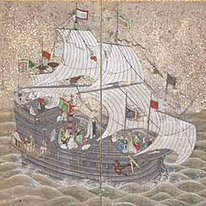Past Exhibitions
- Feature Exhibition; Hidden Treasures from a Merchant’s Storehouse:
The Hiromi Collection, a Legacy of Elegant Living
Part I: A Shipping Brokerage in a Temple Town - February 3, 2018 - March 18, 2018
The Hiromi family is an old merchant family in the city of Kaizuka, in Osaka (not far from Kansai Airport). Their family business, established in 1835, was a shipping brokerage (kaisen don'ya) for the rice trade. Thereafter, they added a variety of other divisions including fertilizer, stock investment, and bank management, which not only grew the family assets but also contributed to the development of modern industry in the region. Their spacious estate includes a 34 meter-wide machiya, a tea house, and four earthen storehouses (kura) filled with a vast treasure trove of artworks—painting and calligraphy, tea utensils, furnishings, and other luxurious objects. These long hidden treasures, including works by Itō Jakuchū, Shiba Kōkan, Shibata Zeshin, and others, have been discovered in recent years and donated to the Kyoto National Museum for preservation, study, and exhibition to the public.
Part I: A Shipping Brokerage in a Temple Town
In the Edo period (1615–1868), Kaizuka was not a feudal domain but a settlement that had grown up around a Jodo Shin (“True Pure Land”) sect Buddhist temple called Gansen-ji. The Hiromi family traces its roots to the related Myōses, also of Kaizuka. In 1835, a Myose daughter married the son of a sake brewer from present day Nishinomiya, Hyogo, and the new couple took the name of Hiromi (“Wide Sea”), which was given to them by Bokuhan Ryōshin, the abbot of Gansen-ji.
This part of the exhibition introduces the Hiromi family and the shipping brokerage business that it established in the seaside port town of Kaizuka. Included are objects related to Kaizuka and to the Bokuhan family as well as works from the collection featuring marine, wave, and ship motifs.












